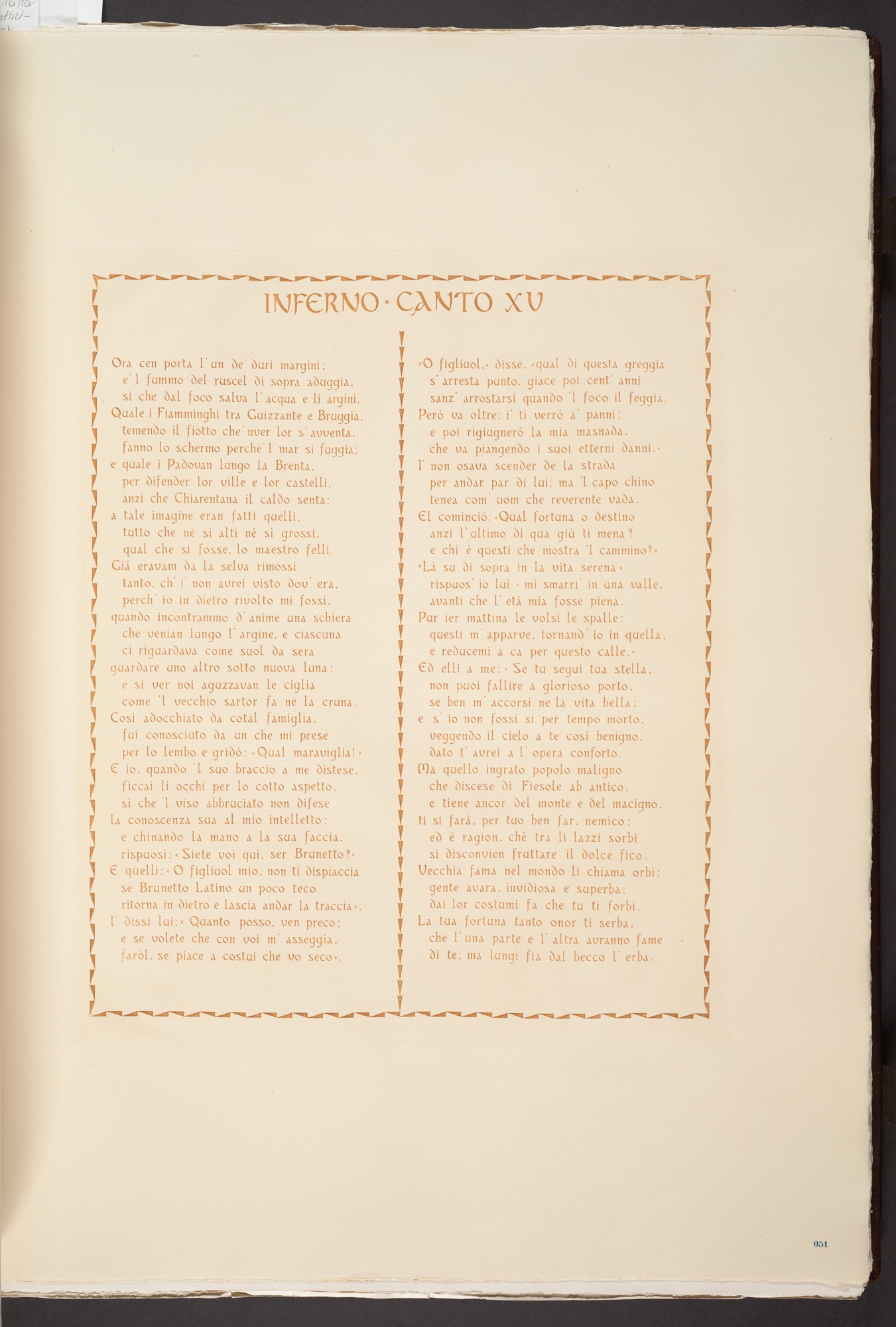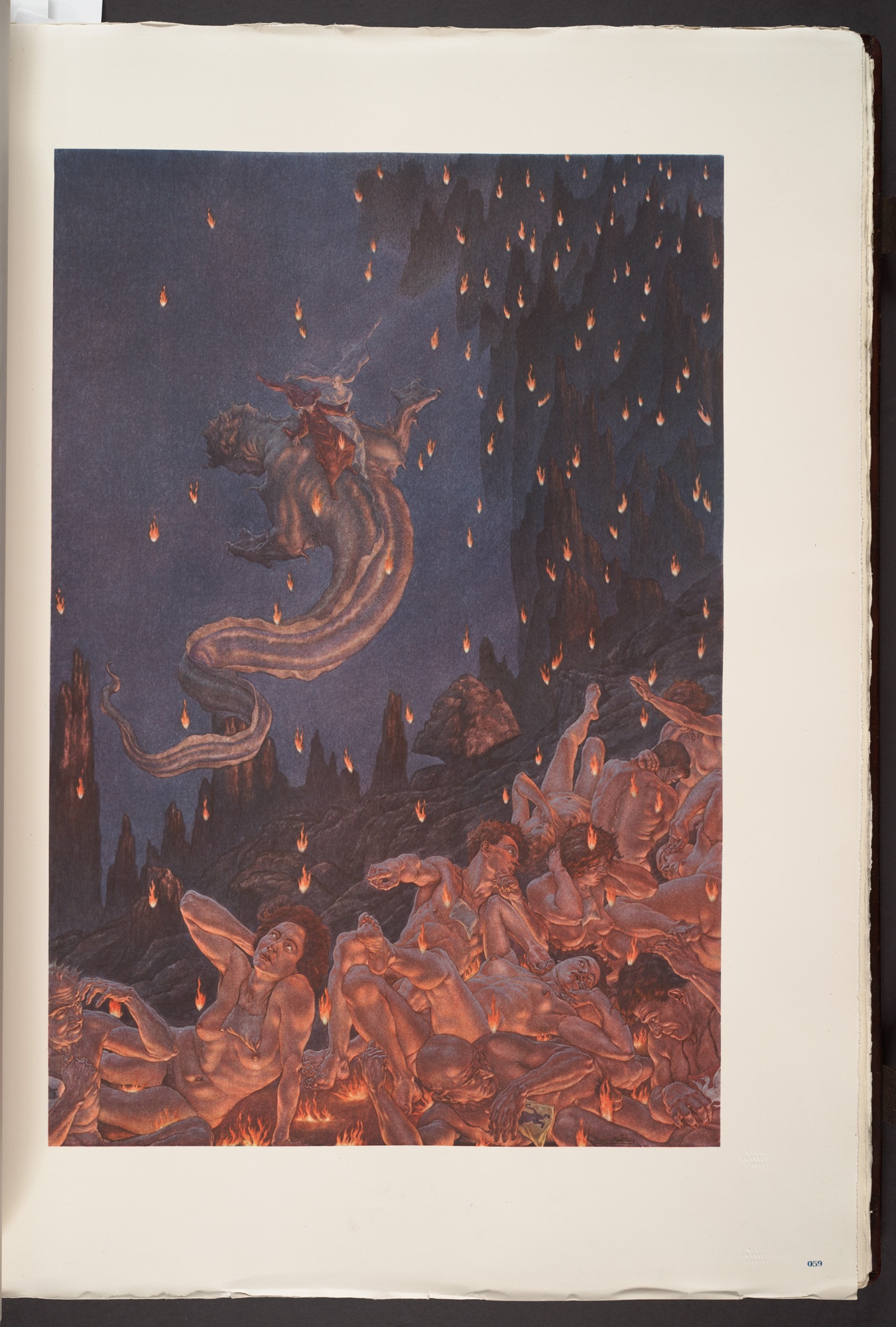Monumental in more ways than one, Amos Nattini’s (1892-1985) gargantuan three-volume edition of Dante Alighieri’s Divine Comedy was produced primarily between 1919 and 1939, although the project extends earlier than its initial conception (1912-1915) and a bit later than the completion of its editorial aspects (c. 1941).

The edition was designed entirely by Nattini himself, a painter originally from Genoa who was encouraged to undertake illustrating the Divine Comedy by journalist-friend Francesco Zandrino as early as 1912. Nattini only began working on his illustration cycle in earnest as of 1919, however, shortly after which time he established a working relationship with a patron, the Milanese lawyer Rino Valdameri (1889-1943), who would finance the entire illustration and editorial project. Nattini and Valdameri together founded the Casa Editrice di Dante (later Istituto Nazionale Dantesco) for the publication of a large-scale (for comparison, each volume could cover the top of an average-sized coffee table) edition of the Divine Comedy in celebration of the six hundredth anniversary of Dante’s death.
As an exquisite (and expensive) luxury item, Nattini’s illustrated Divine Comedy had a limited print run of 1000 copies which were produced following a bespoke model: interested persons and institutions with the means to purchase a copy had to reserve it in advance, and the editions were delivered canto by canto to the purchasers, as they were completed. Details are lacking regarding when and how McGill received the parts that make up its copy of the edition, although the different accession dates for each volume and the incomplete state of the university’s copy of the Paradiso volume suggest that the McGill Library also received its copy piecemeal, likely binding the parts together with the elaborate decorated leather bindings crafted by Nattini once these were received.

The illustrations in the edition, which Nattini called Imagini dantesche, are colour lithograph reproductions of the painter’s larger watercolours that are currently held in the Larini di Collecchio collection (Delsante 1998). These were featured in a plethora of exhibitions throughout the 1920s and 1930s (see Gizzi 1998a), the most impressive of which was the 1931 exhibition of Nattini’s completed Inferno at the Jeu-de-Paume in the Tuileries Gardens in Paris (see: Gizzi 1998a; Depalmi 2007; Cassinari 2012). This first and grandest of Nattini’s exhibitions abroad was endorsed by the Italian Fascist regime and promoted by Mussolini directly, which attests to the high value ascribed to Nattini’s grandiose edition in the period between the two world wars and hints toward why it is not particularly well-known today (see Rivard 2021 for a discussion of this edition in its socio-political and historical context).
The McGill Library acquired a copy of the edition through the generosity of Lady Amy Redpath Roddick (1868-1954), whose benefactions to the university include multiple donations to the library, through the fund she established in 1911 in memory of her younger brothers, Peter Whiteford Redpath (1869-1902) and Jocelyn Clifford Redpath (1876-1901), and the monetary bequest she made in her will, as well as the iconic Roddick Gates that frame the main entrance to McGill’s downtown campus, which she presented to the university in 1924 in memory of her husband, Sir Thomas George Roddick (1846-1923). The copy of the edition was in fact purchased specifically for McGill University, as evidenced by the dedicated limited edition statement included in each volume.

Full title: La Divina Commedia. Imagini di Amos Nattini.
Author: Dante Alighieri (1265-1321), Amos Nattini (1892-1985; illustrator)
Contents: The Divine Comedy in three volumes: Inferno (vol. 1), Purgatorio (vol. 2), Paradiso (vol. 3).
Date of publication: 1931 (vol. 1), 1936 (vol. 2), 1941 (vol. 3)
Place of publication: Milan, Italy
Publisher: Istituto Nazionale Dantesco
Languages: Italian
Physical description: Edition issued in three volumes with colour lithograph illustrations; text printed through copper-plate engraving. Paper produced by hand in double-elephant folio (ivory for text, white for images) specifically for the edition by Fabriano Mills. Each volume measures 830 by 600 mm (according to dimensions recorded in the McGill catalogue record) and is bound in leather with inlaid designs on the front and back covers and hand-stitched silk doublures, all designed by Nattini. Volume 1 has 111 leaves; volume 2, 104 leaves; volume 3, 105 leaves. Printed on recto only; each canto of the poem comprises two leaves of text printed in two columns followed by one image plate, except for Inferno 11 (no illustration) and Inferno 18 (two illustrations).
Call number: McGill Rare Books and Special Collections, double elf PQ4302 F23 1923.
Catalogue: https://mcgill.on.worldcat.org/oclc/427249625
Previous owners: This edition was purchased by subscription specifically for McGill University, at least in part by (or through the memorial fund established by) Lady Amy Redpath Roddick (1868-1954).
Ex-libris and stamps: Vol. 1: McGill University Library accession sticker in top left corner inside front cover (dated 1932). Vol. 2: McGill University Library accession sticker on front fly-leaf (dated 1935), followed by donation sticker in stylized font, reading “Presented to the Redpath Library | McGill University | by | Lady Roddick,” and armorial book plate beneath which is written, “In memoriam | Peter Whiteford Redpath, B.Sc. | Jocelyn Clifford Redpath, B.C.L.”
History of this Copy: This copy of Nattini’s illustrated Divine Comedy appears to have been purchased specifically for McGill by Lady Amy Redpath Roddick (1868-1954). The edition was produced according to a subscription model (Cassinari 2012, 241), with each copy individually dedicated to its recipient: in each volume of this copy, for instance, one reads that it is “Esemplare | numero ottocentoquattordici | per | McGill | University Library Montreal” (‘Copy | number eight-hundred fourteen | for | McGill | University Library Montreal’; my translation). The donation sticker and ‘in memoriam’ armorial bookplate in volume 2 suggest that this volume at least was purchased either directly by Lady Roddick as a gift in memory of her younger brothers, Peter Whiteford Redpath (1869-1902) and Jocelyn Clifford Redpath (1876-1901), or through the memorial fund she had established in their name in 1911 (“Amy Redpath Roddick” 2008).
Lady Roddick was a notable philanthropist and one of McGill University’s most important benefactors of the early to mid-twentieth century. Aside from Nattini’s illustrated Divine Comedy, she donated many books to the McGill Library, whether directly or through the memorial fund she had established in memory of her brothers, and bequeathed $120 000 of her estate to the McGill Library upon her death in 1954 (“Amy Redpath Roddick” 2008). She also presented to the university the gates and clock that frame the main entrance to McGill’s downtown campus in 1924 in memory of her late husband Sir Thomas George Roddick (1846-1923), who had founded the General Medical Council of Canada and was Dean of the Faculty of Medicine at McGill from 1901 to 1908 (“Lady Roddick” 1954; “Amy Redpath Roddick” 2008). Niece to Peter Redpath (1821-1894), who is considered to be the founder of both the Redpath Museum and the McGill Library (now Redpath Hall; both can be found on McGill’s downtown campus), and his wife Grace (d. 1907), Lady Roddick contributed substantial funds for the purchase of fine copies that added to funds previously established by her aunt and uncle; an overview of all Redpath family donations to the McGill library, which includes Nattini’s illustrated Divine Comedy, can be found in the Redpath issue of Fontanus (1993).
Lady Roddick was moreover a published poet and playwright, a member of the Art Association of Montreal, the Canadian Authors Association, and the Canadian Women’s Club, as well as a patron of the Women’s Council of Canada; she is further known for having developed close relations with the Iroquois of the Caughnawaga Reservation, which is reflected in many of her writings (“Lady Roddick” 1954).
Notes: Each volume was issued to McGill in a case measuring 870 by 640 mm. McGill has copy no. 814 of the edition, which presents some differences from the ‘ideal’ physical description provided above. Volume 1 is misbound, with one of the two illustrations to Inferno 18 placed after Inferno 11; volume 3 is unbound and incomplete, comprising the leaves for the front matter up to and including the illustration to Paradiso 20.
Bibliography
“Amy Redpath Roddick.” 2008. Great Unsolved Mysteries in Canadian History: The Redpath Mansion Mystery (web page). https://www.canadianmysteries.ca/sites/redpath/dramatispersonae/amyredpath/indexen.html (accessed on 22/05/2021).
Cassinari, Cinzia. 2012. "Amos Nattini: 'pittore degli spiriti' e poeta della natura", in Divina Commedia: Le visioni di Doré, Scaramuzza, Nattini, edited by Stefano Roffi. Milan: Silvana Editoriale, p. 236-331.
Delsante, Ubaldo. 1998. "Amos Nattini alla Casa di Dante in Abruzzo." Malacoda, 14, p. 35-43.
Depalmi, Valeria. 2007. "Amos Nattini: il rigore di una vita dedicata all'arte", in Amos Nattini: La collezione Pietro Cagnin edited by Elisabetta Bernardelli, Cinzia Cassinari, and Valeria Depalmi. Milan: Silvana Editoriale, p. 27-37.
Emelianova, Irina. 2015. “Il metodo di lavoro di Amos Nattini e l’edizione dell’Inferno”, in Mazzarelli 2015a, p. 28-31.
Gizzi, Corrado. 1998a. "Amos Nattini e la sua austera opera di solitudine feconda", in Gizzi 1998c, p. 17-61.
Gizzi, Corrado. 1998b. "Amos Nattini e Dante", in Gizzi 1998c, p. 115-216.
Gizzi, Corrado, ed. 1998c. Amos Nattini e Dante. Milan: Editoriale Giorgio Mondadori.
Isman, Fabio. 2015. "Pittore di altri mondi: I dipinti di Amos Nattini", Art e dossier, 327, p. 37-39.
“Lady Roddick.” 1954. Canadian Medical Association Journal, 70, no. 4, p. 459.
Mazzarelli, Carla. 2015a. “Monumenti a Dante tra letteratura, arte e architettura”, in Mazzarelli 2015a, p. 16-23.
Mazzarelli, Carla, ed. 2015b. Amos Nattini e la Divina Commedia figurata tra le due guerre: Arte, architettura e lettere in dialogo. Museo Comunale d’Arte Moderna Ascona 26.10-30.12.2015. Exhibition guide. Ascona: Museo Comunale d’Arte Moderna Ascona.
"Redpath Issue." 1993. Fontanus from the collections of McGill University, 6.
Rivard, Casey-Anne. 2021. “Beyond Dante: The Figural Embodiment of a Fascist Ethos in Amos Nattini’s Lucifer”. Master’s thesis, McGill University.
Author and date of the record: Cay Rivard, 21/06/2021.